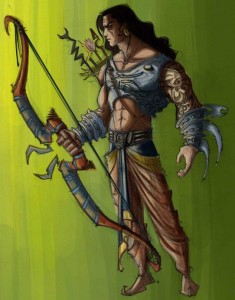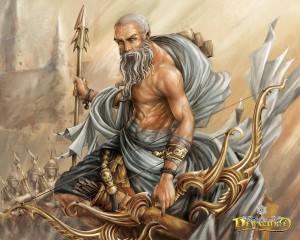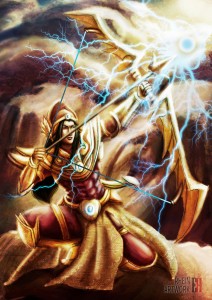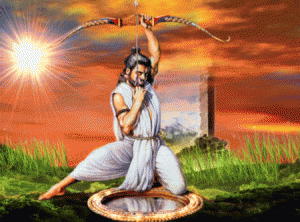Barbarika,
a furious warrior who could have ended the great war of Mahabharata in just a
minute. Surprised? I know you must be thinking how? Who was he? Well, let’s
know.
Barbarik was the son of
Ghatotkach and the grandson of Bheem. Having learnt the art of warfare from his
mother, Maurvi, he was a brave warrior even in his childhood.
THE
“BEARER OF THREE ARROWS”
Pleased with Barbarika’s penance, Lord Shiva
granted him three meticulous arrows as a boon. Hence, he was honored as “Bearer
of three arrows.” Later, Agni Dev (The God of fire) gave him a bow which
was capable to mark his victory in the three Worlds.
1. The first arrow would mark his enemy with red ink
2. The second arrow would mark the things that he wanted to save
3. The third arrow would destroy enemy target marked with red ink in the first step or destroy everything not marked in step 2
THE MAHABHARAT WAR
Before the Mahabharat war
began, Lord Krishna asked all the warriors how many days it would take them to
finish the war alone. Bhisma replied it would take him 20 days. Dronacharya
said he would take 25 days. Karna said it would take him 24 days and Arjuna
said it would take him 28 days. But Barbarik astonished Krishna with his
answer. He said it would take him 1 minute to win the battle by himself.
THE CONVERSATION BETWEEN KRISHNA AND BARBARIKA
Once, while
Barbarika was riding his blue horse, a Krishna came in the way. Krishna asked
Barbarika who he was? “I am the son of Ghatotkacha and Maurvi (Ahilyavati) and
the grandson of Bhima and Hidimba and I am the most powerful warrior in the
world,” answered Barbarika.
Krishna then
asked him in how many days he can end the Mahabharata war alone? Barbarika
proudly answered that he is skilled to finish the war in a single minute. With
the sound of disbelief, Krishna asked him how can he end the war with just
three arrows?
·
“With
the first arrow, I can mark everything I want to destroy. When I release the
third arrow, everything that is marked will be destroyed and the arrow will
return to the quiver.
·
The
second arrow can mark everything that I wish to save. Now again when I fire the
third arrow, everything that isn’t marked will be destroyed.” replied
Barbarika.
In a
challenging manner, the Krishna asked Barbarika to destroy all the leaves of
the peepal tree below which they were standing. Barbarika, before releasing the
arrow closed his eyes. In meanwhile, Krishna plucked a leaf from the tree and
hid it beneath his foot. When Barbarika released his arrow, it destroyed all
the leaves and pierced Krishna’s foot to mark the leaf that was hidden under
his foot.
Krishna then asked Barbarik from whom side will he
participate in the war? Without any thought, Barbarika answered, “I have
promised my Mother that I will support the weak side. As the Pandavas have
only seven Akshauhini armies compared to the eleven of the Kauravas, I will
fight for the Pandavas.”
PARADOX OF BARBARIK’S
IMPOSSIBLE PROMISE
Krishna then asked
Barbarik about the side he was planning to fight for in the war of Mahabharat. Babrbarik expressed his desire to fight
for the Pandavas as they were the weaker side. (as promised to his guru).
But Krishna
then revealed the paradox of Barbarik’s impossible promise: since the power of the 3 arrows made him the most powerful
warrior on the battlefield, whichever side he joined would make the other side
weaker. Eventually, he would end up switching sides infinitely until he
destroyed everyone but himself. So
to avoid this consequence, Krishna asked for Barbarik’s head
But Barbarik
expressed his desire to witness the epic battle of Mahabharat. Krishna promised
him that even after his head was severed from his body, his head would be in a
conscious state and that it would be placed on a hill overlooking the
battlefield, so that he could witness the whole war.
Barbarik, being a true warrior
and disciple of Lord Krishna, readily agreed and severed his own head. Bheem
then took the head of the greatest Kshatriya and placed it on the top of a hill
as promised.
BARBARIK’S CONCLUSION
At the end of the war,
the Pandavas argued amongst themselves as to who was responsible for their
victory. Krishna suggested that Barbarik should be allowed to make that
decision as he was a neutral witness to the whole war. To this Barbarik concluded that it was Krishna
alone who was responsible for the Pandava’s victory: his advice, presence of
mind and game-plan were the most crucial.
BARBARIKA AS KHATU SHYAM JI IN KALIYUG
Obliged by
the sacrifice of Barbarika, Krishna grants him a boon. “You will be
wholeheartedly worshipped by the name of Shyam in my form when Kaliyug arrives.
The devotees who will seek your blessing would be granted their wishes.”
As a result
of Krishna’s boon, We now worship Barbarika in the form of Khatu Shyamji. The famous temple
named Khatu Shyamji is located in the Sikar district of Rajasthan. There
is a Shyam pond at a little distance from the temple where the head of Shri
Shyamji had appeared. Many devotees believe that by bathing in that pond, the
diseases of the body are cured.











